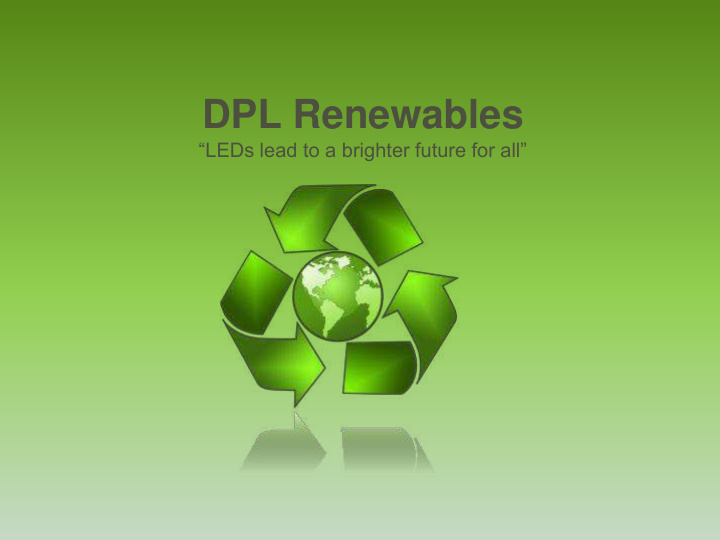



DPL Renewables “LEDs lead to a brighter future for all”
Energy Efficient Lighting Solutions • Cut your energy bills • Eliminate downtime • Improve productivity • Reduce maintenance costs
What can I do to reduce my energy consumption and carbon footprint? • Reduce lighting energy consumption by using more efficient light sources such as LED or T5 Fluorescent, linked with daylight dimming and presence detectors • Fit renewable energy generators – Solar Photo Voltaic, Wind Turbines or Solar Thermal • Change equipment to more efficient models – heat pumps, hand dryers
Why change to energy efficient lighting? • Save up to 80% on your lighting bills • Reduce maintenance costs – no lamp changes • Get a quick return on your investment – typically 2-3 years • Keep ahead of energy price increases • Qualify for a Carbon Trust 0% loan – monthly energy savings will be exceed monthly repayments • Qualify for Enhanced Capital Allowance tax relief - 23% of cost • Improve working conditions – improve staff well-being, therefore productivity • Become part of a sustainable business supply chain • Visually demonstrate corporate efforts to reduce carbon
Financial reasons to install energy efficient lighting • Lighting in a large commercial or industrial site can be responsible for up to 70% of the onsite electricity usage • By using energy efficient lighting technologies up to an 80% saving of lighting consumption can be made • By using presence detectors and daylight dimming a further saving of lighting energy consumption can be made of up to 50% • Investing in energy saving lighting provides a quick, guaranteed return – typically 2-3 years • Many indirect financial benefits are achieved – reduced maintenance costs, better productivity due to improved working conditions, avoid penalties of new stringent environmental regulations and levies • NO CAPITAL EXPENDITURE – Energy saving lighting qualifies for Carbon Trust financial assistance, 0% loans and only repaying what you have saved in energy cost
Comparison between LED lighting and Fluorscent lighting Total 20 Year Energy Consumption 600000 500000 400000 300000 200000 100000 0 1 2 3 4 5 6 7 8 9 10 11 12 13 14 15 16 17 18 19 20
Operational benefits • Less disruption to production due to lower maintenance requirements • More comfortable working environment – improving staff productivity, due to better “quality” of light • Full brightness of light instantly • Address existing health and safety issues – eliminate dimness in dangerous working areas, lower glare, reduce electrical risks – this can protect a business against liability and improve a site to an example of best practice
Environmental benefits • Reduce carbon footprint • Demonstrate Corporate Social Responsibility (CSR) initiatives and a carbon reduction strategy to supply chains and customers – lighting gives an instant visual demonstration to visitors • Longer maintenance intervals – no more lamp changes, eliminating the requirement for specialist disposal under the WEEE directive
ECA (Enhanced Capital Allowance) The Enhanced Capital Allowance (ECA) Scheme is a key part of the Government’s programme to manage climate change . First-year Enhanced Capital Allowances (ECA) allows the full cost of an investment in designated energy-saving plant and machinery e.g. LED lighting. This means it can be written off against the taxable profits of the period in which the investment is made. This in term could save a lot of money and result in a reduced carbon footprint. These products must be registered under the Energy Technology List (ETL) to be eligible for the 100% tax relief under the ECA scheme.
ECA Benefits (Enhanced Capital Allowance) There are several benefits to purchasing ETL products for the ECA scheme including: • Reduced energy bills (increased tax benefit in the long term) • Reduced payback periods when purchasing LED lighting or other ETL products • Reduced costs through operation & maintenance • Increased product efficiency • Reduction to carbon footprint on the environment • Reduced energy consumption rate
Why You Need To Save Energy? Electric lighting is a major source of energy consumption but also offers a significant opportunity to reduce energy usage. The UK government is committed to reducing our carbon emissions by 34% of 1990 levels by the year 2020. Energy costs are rising by 10-12% per annum (based on DECC figures) and a climate levy charge has now become payable. Investing in the latest lighting technology along with professional lighting design, can significantly reduce energy consumption.
The DPL Renewable Solution Sustainability The right light In the right place at the right time Efficiency Cost Saving When is it needed? What have you got? Let us do a survey. Is free daylight available? Is anybody there? Use a better technology! How much is it costing you? Is now the right time for LED? Capital costs, energy costs and maintenance costs = total cost of ownership – ROI Use it in a better way! Efficient lighting design, efficient optics.
The DPL Renewable 3-Step Energy Plan • Site survey 1 • Determine energy costs £ p/kwh DPL • Determine operating hours Energy Efficiency Study • Consider current lighting regulations • Obtain site plans or drawings • Good lighting design 2 • Correct control gear DPL • Efficient light source Energy Efficiency • Calculation & Proposal Lighting controls daylight linking & PIR • Efficient luminaires • 5 year warranty 3 • DPL Installation partners • Finance advice in conjunction with SALIX, Completion Services Siemans, ECA and the green deal
Our clients • PV KITS DIRECT • BABCOCKS INTERNATIONAL • PORSCHE • HARWICH INTERNATIONAL PORT • AMSHOLD • PORT OF FELIXSTOWE • SEALEYS POWER PRODUCTS
Recommend
More recommend